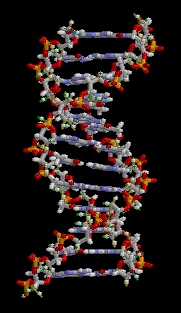
Introduction to genetics
Background Information
This content from Wikipedia has been selected by SOS Children for suitability in schools around the world. Visit the SOS Children website at http://www.soschildren.org/

Genetics is the study of how living things receive common traits from previous generations. These traits are described by the genetic information carried by a molecule called DNA. The instructions for constructing and operating an organism are contained in the organism's DNA. Every living thing on earth has DNA in its cells.
A gene is a hereditary unit consisting of DNA that occupies a spot on a chromosome and determines a characteristic in an organism.
Genes are passed on from parent to child and are an important part of what determines physical appearance and behaviour.
A gene will also determine what traits a whole family (such as the grandfather, great grandfather, etc.), will have, because of the genes passed down in existing chromosomes.
Glossary
It helps to know the technical words used:
- DNA is a long molecule that has the form of a " double helix". It resembles a ladder that has been twisted. In cells with nuclei, which make up animals and plants, the DNA is stored inside the cell nucleus, while in cells without nuclei, such as bacteria, the DNA is in the cell's cytoplasm.
- Nucleotides form the rungs of the DNA ladder. There are four types of nucleotides, and the sequence of nucleotides carries the information in the DNA.
- A chromosome is a package for carrying the DNA in the cells. Different species of plants and animals have different numbers of chromosomes.
- A gene is a segment of a DNA molecule on a chromosome. The genes are like sentences built up of the "letters" of the nucleotide alphabet, and between them the genes direct the physical development and behaviour of the organism.
- Alleles are the different forms of a given gene that an organism may possess. For example, in humans, one allele of the eye-color gene produces green eyes and another allele of the eye-colour gene produces brown eyes.
- A population is a localized group of individuals belonging to the same species. For example, all the trout of the same species sharing a single stream is a population.
- A gene pool is the sum of all the alleles shared by members of a single population.
Dicovery of genetics

Darwin’s theory of natural selection laid the groundwork for evolutionary theory. However, it was the emergence of the field of genetics, pioneered by Gregor Mendel (1822-1884), that provided the missing information on how evolution works in practice. Mendel’s experiments with peas led him to realise that heredity in sexual reproduction works by the mixing of separate factors, not by the blending of inherited characters. This combination of Darwin's theory and our current understanding of heredity led to the birth of the scientific area called " population genetics".
Genetics role in disease
New studies are regularly being published that expose the role that the genetics play in various disorders. Some disorders are mainly hereditary, while other disorders are mainly caused by the environment - bacteria, viruses, or people's diet - and many disorders have both a hereditary as well as an environmental component. Even complex disorders, such as Leukemia have some genetic component.

